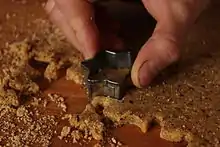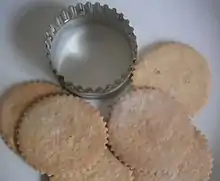Cookie cutter
A cookie cutter in American English and biscuit cutter in Commonwealth English is a tool to cut out cookie/biscuit dough in a particular shape.

Cutting Christmas cookies.

A simple cookie cutter.
They are often used for seasonal occasions when well-known decorative shapes are desired, or for large batches of cookies where simplicity and uniformity are required. Cookie cutters have also been used for, among other uses, cutting and shaping tea sandwiches.
Types and variations
- Cutout
- Most commonly made of copper, tin, stainless steel, aluminium, or plastic. Cutouts are the simplest of the cookie cutters; the cutter is pressed into cookie dough that has been rolled flat to produce the shape of the cutter's outline. To keep the dough from sticking, they are often dipped in flour or sugar before use.[1] [2]
- Detail imprint
- Commonly made of copper, tin, or plastic. Detail imprints are similar to cutout cookie cutters, except that detail imprints also mark the surface of the dough.
- Cookie mould
- Usually made of wood, ceramic, or plastic. Springerle moulds are the oldest examples of such, and are popular for Scottish shortbread.[1] A cookie mould typically has an ornate design debossed into the surface; the mould is pressed into the cookie dough to produce an embossed design. These moulds may be flat disks or may be in the shape of a rolling pin.
- Cookie press
- An automated or hand-operated cookie press, also called a cookie gun, is used to make large batches of cookies quickly. The cookie dough is extruded onto the baking sheet in ornate shapes that would otherwise be too difficult or time-consuming to create by hand.[1]
- Cookie cutting sheet
- Used for larger volumes, a production cookie cutting sheet is a piece of study plastic the size of a full sheet pan that essentially has dozens of cutout cookie cutters mounted on to it.[1] Rather than rolling out the dough and pressing the cutter into the top of the dough, the cutting sheet is placed of the baking sheet, cutting side up. A sheet of cookie dough, already rolled to the correct thickness, is laid on top of the cutting sheet, and a rolling pin is used to press the dough down on to the sharp edges of the cutting sheet. The cut cookies fall through the holes into the sheet, into their properly spaced positions on the baking sheet. The scrap dough and cutting sheet are removed, and the pan is ready for baking. Cookie cutter sheets allow high volume production without the time or risk of moving cut cookies to baking sheets, resulting in rapid production of a more uniformly shaped and spaced product.
See also
References
- Rinsky, Glenn and Rinsky, Laura Halpin. The Pastry Chef's Companion: A Comprehensive Resource Guide for the Baking and Pastry Professional. John Wiley & Sons; 4 February 2011. ISBN 9781118060667. p. 77.
| Wikimedia Commons has media related to Cookie cutters. |
This article is issued from Wikipedia. The text is licensed under Creative Commons - Attribution - Sharealike. Additional terms may apply for the media files.